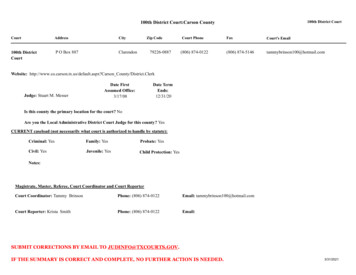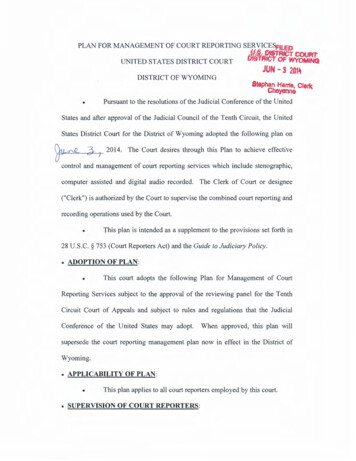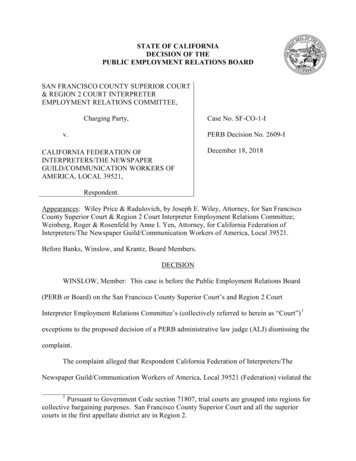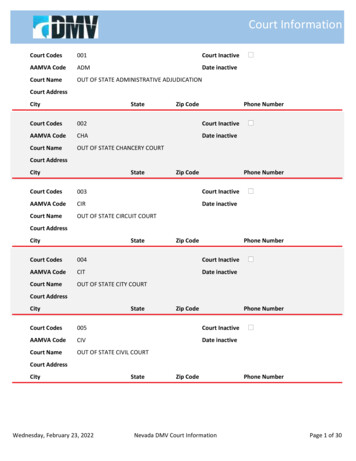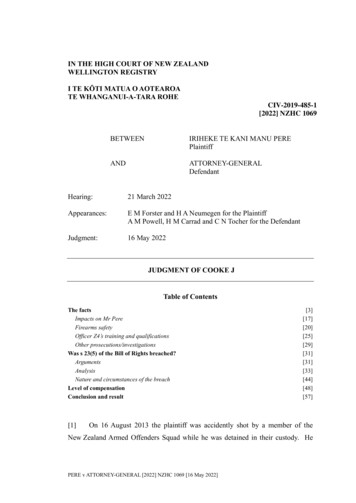
Transcription
IN THE HIGH COURT OF NEW ZEALANDWELLINGTON REGISTRYI TE KŌTI MATUA O AOTEAROATE WHANGANUI-A-TARA ROHECIV-2019-485-1[2022] NZHC 1069BETWEENIRIHEKE TE KANI MANU 1 March 2022Appearances:E M Forster and H A Neumegen for the PlaintiffA M Powell, H M Carrad and C N Tocher for the DefendantJudgment:16 May 2022JUDGMENT OF COOKE JTable of ContentsThe factsImpacts on Mr PereFirearms safetyOfficer Z4’s training and qualificationsOther prosecutions/investigationsWas s 23(5) of the Bill of Rights breached?ArgumentsAnalysisNature and circumstances of the breachLevel of compensationConclusion and 7]On 16 August 2013 the plaintiff was accidently shot by a member of theNew Zealand Armed Offenders Squad while he was detained in their custody. HePERE v ATTORNEY-GENERAL [2022] NZHC 1069 [16 May 2022]
brings these proceedings seeking compensation for a breach of his right under s 23(5)of the New Zealand Bill of Rights Act 1990 (the Bill of Rights). This provides:Everyone deprived of liberty shall be treated with humanity and with respectfor the inherent dignity of the person.[2]The key issues in this case are whether the facts which are agreed between theparties give rise to a breach of this right, and if so, what compensation should beawarded for that breach.The facts[3]As indicated the relevant facts have been agreed between the parties in the formof an agreed statement of facts admitted under s 9 of the Evidence Act 2006. Theparties and their counsel are to be commended for reaching this agreement, not onlybecause it has allowed for an efficient hearing, but also because it has removed thefurther stress for the participants yet again giving evidence about these events.[4]Mr Pere was aged 33 at the time of the accidental shooting. He was living withhis mother in Hastings.[5]He has a complex medical health history and has been diagnosed withdepression and social bi-polar disorder. He had suffered previously from psychoticepisodes. He was known to police having accrued 41 convictions between April 2000and April 2003 including for violent offending. He was the subject of an ArmedOffender Squad callout in 2009. From August 2011 he was a compulsory patient underthe Mental Health (Compulsory Assessment and Treatment) Act 2002 and was subjectto an indefinite community treatment order. The order was discharged in July 2013.From this time Mr Pere was a voluntary patient.[6]The relevant events occurred on 16 August 2013. Mr Pere had ceased takinghis medication regularly at this time. He was consuming recreational drugs andexperiencing a deterioration in his mental health. Mr Pere’s mother rang the HawkesBay District Health Board’s mental health unit seeking assistance. She then attendedthe Napier Health Centre and spoke to Ms Joanne Wainwright, an employee of theHawkes Bay District Health Board Mental Health Unit who was the case worker
assigned to Mr Pere. Mrs Pere informed Ms Wainwright that Mr Pere appeared to behaving a psychotic episode. She said that two days earlier he had waived what shebelieved was a BB-gun around, including pointing it in her direction, and that Mr Perehad subsequently stowed the BB-gun in his bedroom. A BB-gun is a type of air gundesigned to shoot metallic spherical projectiles called BBs. BB-guns are classified asairguns under the Arms Act 1993. Anyone over the age of 18 may use an airgunwithout a firearms licence, but it is an offence to possess an airgun other than forlawful, proper and sufficient purpose.[7]At about 2.26 pm that day Ms Wainwright rang the New Zealand Police andinformed them of the content of her conversation with Mrs Pere. Following that callpolice made an operational decision to activate the Hawkes Bay Armed OffendersSquad to apprehend Mr Pere. Police knew of Mr Pere’s mental illness because of theinformation supplied by Ms Wainwright and from the police’s prior dealings withMr Pere.[8]At 3.26 pm following a briefing at Hastings Police Station Armed OffendersSquad officers including Officer Z4, a dog unit, and a police negotiation team weredespatched to set up an outer cordon around the address where Mr Pere lived with hismother. At 4.03 pm the officers, including the police dog unit, established a commandvehicle base at a designated safe forward point. At 4.46 pm police established roadblocks. The Armed Offenders Squad, including Officer Z4 then deployed forward tothe address.[9]All Armed Offenders Squad officers were armed with .223 Calibre M4Bushmaster rifles. They wore standard issue uniforms that included a tactical vest anda sling for holding the rifles. Some of the rifles were mistakenly loaded withRemington .223 training rounds, including Officer Z4’s rifle. This was because,contrary to protocol, the training rounds had not been replaced with standard roundsafter the last training exercise. A training round is a live frangible bullet that isdesigned so that when it hits a solid surface it disintegrates into tiny pieces to minimisethe bullet’s penetration into the object it has hit. A standard hollow point round isdesigned to penetrate its target and disintegrate after impact.
[10]At 5.23 pm police requested Mr Pere to surrender to police for arrest uponsuspicion of possession of a pistol without lawful or sufficient purpose contrary to s 45of the Arms Act. Mr Pere duly surrendered himself and acquiesced in the arrest bypolice.[11]As part of his arrest Mr Pere was lain prone face down on the ground outsidethe address. When Officer Z3 undertook the arrest he first gave his Bushmaster rifleto another police officer. Mr Pere was then handcuffed behind his back with plastichandcuffs by Officer Z3. Officer Z4 was then tasked with assisting with the detentionof Mr Pere while other Armed Offenders Squad officers entered the address to searchit. Officer Z4 checked that that the safety catch on his Bushmaster rifle was in the safeposition before doing so. He also made sure that the rifle, which was held in a sling,had its muzzle pointing away from Mr Pere as he approached. He knelt beside Mr Perewith one knee on the ground and the other on Mr Pere’s back. He informed Mr Pereof his arrest rights under the Bill of Rights. Mr Pere was cooperative throughout thearrest. After Mr Pere was arrested Officer Z4 stood up and moved his Bushmasterrifle to the front of his body and stepped back one or two metres.[12]There was no other apparent danger to the public or police officers at the scene.Other uniformed police then arrived at the address to take Mr Pere to the police stationfor processing. A request was given to the attending officers to replace the plastichandcuffs with metal handcuffs to enable his transfer into custody of the uniformedofficers.[13]Officer Z4 had his Bushmaster rifle suspended in front of him from a sling. Hethen moved forward to assist other officers to change the handcuffs on Mr Pere.Before doing so Officer Z4 did not remove the round in the chamber of the Bushmasterrifle. He did not remove his Bushmaster rifle and put it in the custody of anotherofficer or in another safe place. Nor did he check that the safety catch on theBushmaster rifle was in the safe position so that it could not fire.[14]While the handcuffs were being replaced Officer Z4 bent over to assist otherofficers to lift Mr Pere to his feet. When doing so he did not ensure that the muzzle ofhis Bushmaster rifle pointed away from anywhere that if it fired would cause harm.
The muzzle of the Bushmaster rifle was pointing directly at the central upper area ofMr Pere’s back while Mr Pere was lying prone face down on the ground outside theaddress. The muzzle of the rifle was near Mr Pere’s back.[15]The way Officer Z4 had set up his vest on his uniform meant that when heshifted his Bushmaster rifle across to the right side of his body the safety catch of theBushmaster rifle brushed against the stiff fabric holster for his Glock pistol. Thiscontact is likely to have caused the safety catch on the Bushmaster to have shiftedfrom the safe position to a position that enabled the Bushmaster rifle to fire withoutOfficer Z4 knowing it.[16]As Officer Z4 bent down to help lift Mr Pere to his feet with the Bushmasterrifle suspended in the sling, the lower buckle on his vest entered the trigger guard ofthe rifle and caught on the trigger. The weight of the rifle moving in the sling againstthe buckle was sufficient to pull the trigger. The rifle discharged a single frangiblebullet at close range into the central/upper area of Mr Pere’s back. Officer Z4 did notintend to fire his rifle and did not depress the trigger with his finger.Impacts on Mr Pere[17]Mr Pere was taken to hospital suffering from blood loss, a collapsed lung,injury to blood vessels and had shrapnel from the frangible bullet lodged in his upperback and spread through his chest area and neck areas. He required extensive medicaltreatment but not surgery. He was in hospital for a month.[18]Mr Pere had experienced acute mental health events in the past but sufferedfurther shock and distress and complications with his mental illness because of whathappened during his arrest.[19]Had Officer Z4’s Bushmaster rifle been armed with standard life ammunitionas intended for armed offenders squad deployment, Mr Pere’s physical injuries wouldhave been more serious and likely fatal.
Firearms safety[20]The Interim Amended Firearms Instruction Manual was in use at the time ofthe shooting. In the chapter entitled Rifle Operator four cardinal rules of firearmssafety are set out, namely:[21]1.All guns are loaded.2.Point muzzle in a safe direction (‘laser rule’).3.Keep your finger outside the trigger guard until you are on target andhave decided to fire.4.Be sure of your target and what is around it.The Bushmaster M4A3 manual provides a similar set of four rules. Rule 2states:Point the muzzle in a safe direction. (Remember the “Laser Rule”: Treat anyfirearm as if it has a laser fitted through the axis of the barrel. Whatever thebeam touches, it cuts through).[22]In addition the manual comments:Be conscious of where the muzzle of the firearm is pointing at all times. Neverpermit your muzzle to cross anything that you are unwilling to shoot.[23]Expert evidence has also been provided from Tracy Short. He confirms that:(a)Allowing the loaded firearm to unintentionally point at a person was acareless omission.(b)Moving forward to physically assist Mr Pere to get up without checkingthe safety catch while holding a loaded firearm was a careless omission.(c)Moving forward to physically assist Mr Pere to get up withoutneutralising the danger from his firearm by removing the live roundfrom the chamber or by putting the rifle in the custody of another officeror in a safe place was a substandard and dangerous use of a firearm.
[24]It is also accepted that the qualification process to become an Armed OffendersSquad member includes how the firearm safety rules apply including ensuring thesafety catch is on and observing the laser rule, and if there is cover from anotherofficer, provide the rifle to that officer.Officer Z4’s training and qualifications[25]To be a member of the Armed Offenders Squad a candidate needs to be aserving police officer. That officer must first complete the Armed Offenders Squadselection course and then the national Armed Offenders Squad qualification course.Following that the officer can apply for a position in an Armed Offenders Squadfollowing which they go through an induction and mentoring process.[26]Officer Z4 graduated from police college in 2007 and completed probationaryrequirements in April 2009. He attended an Armed Offenders Squad selection coursein March 2010. Due to concerns about his performance on the course he was given aconditional pass on the basis he subsequently receive one on one tutoring. Theconcerns related to decision-making in operational settings.[27]On 31 July 2013 due to a shortage of qualified Armed Offenders Squadmembers a decision was made by the Police Commander of National Tactics Groupsto deploy trainee members in Hawkes Bay provided that they would not be used forhouse clearing unless there was no alternative.[28]As at the date of the accidental shooting on 16 August 2013, Officer Z4 was atrainee Armed Offenders Squad member and was designated part of the Hawkes BayArmed Offenders Squad. He had not received any one on one training since the ArmedOffenders Squad selection course. He had not been inducted and had not had anymentoring. At the time there was no formal induction or mentoring programme forArmed Offenders Squad officers. There was no training plan in place for him otherthan that he was due to attend the Armed Offenders Squad qualification course inSeptember 2013. He was current with his general firearms training for pistol and riflewhich is a qualification for police outside of the armed offenders squad.
Other prosecutions/investigations[29]In April 2015 Officer Z4 was charged with careless use of a firearm causinginjury under s 53 of the Arms Act 1983. In February 2016 after trial before a Judgeand jury in the District Court at Napier he was found not guilty and acquitted.[30]On 31 May 2016 the Independent Police Conduct Authority (IPCA) issued areport finding on the balance of probabilities that Officer Z4’s failure to know wherehis Bushmaster’s rifle was pointing was careless in the circumstances.Was s 23(5) of the Bill of Rights breached?Arguments[31]For Mr Pere Mr Forster argued that liability for Bill of Rights compensationarose. No claim in tort could be advanced as a consequence of s 317 of the AccidentCompensation Act 2001. A claim for exemplary damages was preserved by s 319 ofthat Act but it was accepted that no basis for exemplary damages existed here.Mr Forster focused on s 23(5) of the Bill of Rights. He emphasised that Officer Z4was dealing with a cooperative and handcuffed man lying prone face down on theground. Officer Z4’s actions were not just a one off as he engaged in a series of errorsthat led to the shooting. This distinguished the case from that in A v Attorney-Generalin which the High Court had dismissed a claim under s 23(5) where a prison guard hadmade a mistake when directing that the plaintiff be mixed with prisoners from a rivalgang who then assaulted him.1 Mr Forster also argued that there were systemicshortcomings involved in this case and also relied on other rights in the Bill of Rights,including the right to life in s 8, although they were not pressed in oral argument.[32]For the defendant Mr Powell argued that the relevant standard for assessing abreach of s 23(5) was that set out by the Supreme Court in Taunoa v AttorneyGeneral.2 A breach of s 23(5) could arise from a failure to keep a detainee safe, albeitas Ellis J held in S v Attorney-General the simple fact that a detainee has come to harmdid not mean there was a breach of the right.3 Some breach of standards by the123A v Attorney-General [2020] NZHC 3401.Taunoa v Attorney-General [2007] NZSC 70, [2008] 1 NZLR 429.S v Attorney-General [2017] NZHC 2629 at [243].
detaining authorities was required. Mr Powell accepted that in the circumstances ofthis case it would be open for the Court to find that Officer Z4 had owed a duty toMr Pere to take reasonable care to ensure that he did not injure him with the weaponhe was carrying, and that this duty had been breached. It might then be open for theCourt to conclude that this comprised a breach of s 23(5). He argued that there wasno systemic element to any breach of the standard, however.Analysis[33]The key question in this case is whether Mr Pere’s right under s 23(5) wasbreached.This may depend on whether a breach of this right can arise as aconsequence of harm caused to a detainee that is accidental rather than intentional.For the reasons I elaborate upon below I have decided that it can, and that such abreach arose in the present case.[34]The right to be treated with humanity, and with respect for the inherent dignityof the person can be seen to be at the heart of all fundamental human rights. Whenthe state assumes control over the personal autonomy of a person by detaining themsuch concepts assume particular significance, and this is reflected in the existence ofthe separate right in s 23(5) of the Bill of Rights. It is derived from Article 10(1) ofthe International Covenant on Civil and Political Rights. In other human rightsinstruments, such as the European Convention there is no express article to the sameeffect, but the existence of the right arises by implication given the centrality of theconcepts of humanity and inherent dignity.4[35]The leading New Zealand authority on the nature and extent of the right arisingunder s 23(5) is the decision of the Supreme Court in Taunoa v Attorney-General. TheCourt there referred to the decision of the European Court of Human Rights in Kudlav Poland which was said to have captured the flavour of s 23(5) in the following way:5 The State must ensure that a person is detained in conditions which arecompatible with respect for his human dignity, that the manner and method ofthe execution of the measure do not subject him to distress or hardship of anintensity exceeding the unavoidable level of suffering inherent in detention in45Convention for the Protection of Human Rights and Fundamental Freedoms 213 UNTS 221(opened for signature 4 November 1950, entered into force 3 September 1953).Kudla v Poland (2000) 10 BHRC 269 at [94]. See Taunoa, above n 2, at [156] per Blanchard J.
that, given the practical demands of imprisonment, his health and wellbeingare adequately secured [36]In Taunoa the Supreme Court explained the difference between the rightarising under s 23(5) and that arising under s 9 of the Bill of Rights not to be subjectedto torture or cruel, degrading, or disproportionately severe treatment or punishment.There were degrees of infringing conduct evident in ss 23(5) and 9. Section 23(5) wasconcerned with conduct which was unacceptable but not rising to a level ofoutrageousness covered by s 9.6 In describing the differences Tipping J said:7 I consider different considerations apply to a case in which the State is saidto have failed to observe the positive duty contained in New Zealand’s s 23(5),which requires those deprived of their liberty to be treated with humanity andwith respect for their inherent dignity as persons. A failure to observe thatpositive duty is different from a breach of s 9. In the case of s 23(5), theperson concerned can claim that the statutory standard has not been met.It does not matter for liability purposes why that is so. The State’s duty isto achieve an objectively defined outcome. It is, however, of moment towhether there has been a breach of s 9 to consider the state of mind of theparty said to be in breach and the consequences for the victim of the impugnedconduct.(emphasis added).[37]So whilst the state of mind of the party said to be in breach is relevant to s 9, itis not necessary to establish a breach of s 23(5). Section 23(5) gives rise to a positiveduty. The Court’s enquiry is directed to identifying whether standards arising fromthe positive obligation to treat detainees with humanity and inherent dignity have beenobserved. As Ellis J said in S v Attorney-General:8Many cases invoking s 23(5) concern actions by a detaining authority that areself-evidently inconsistent with the dignity or humanity of the detainee, suchas unnecessary use of force or assault. For example, the intentional inflictionof injuries by a police officer and inappropriate use of pepper spray against aperson in custody have been found to breach s 23(5).9But inaction, neglect or failure to take the necessary steps to ensure thehumane treatment of a detainee have also been discussed by the courts, andpositive duties recognised under s 23(5). There is no doubt (and therespondents accept) that s 23(5) requires the State not simply to refrain frominhumane conduct, but also to act to maintain minimum conditions ofdetention, as defined in the statute authorising the detention, subordinatelegislation and/or any relevant standards. 6789Taunoa v Attorney-General, above n 2, at [170].At [294].S v Attorney-General, above n 3, at [216]–[217].Falwasser v Attorney-General [2010] NZAR 445 (HC).
[38]An illustration of a breach of such standards arising through non-deliberatebehaviour is to be found in Attorney-General v Udompun.10 Here Mrs Udompun hadbeen detained at the airport and then transferred to a police station. In that process shehad been denied the opportunity for a change of clothes and also deprived of sanitarypads which she needed. A full Court of the Court of Appeal upheld the finding thatthis involved a breach of s 23(5). They held:We accept Heath J’s formulation of the issue as whether the standards ofadministration applied to Mrs Udompun during her detention weresatisfactory in light of the guarantees provided in s 23(5). Looked at in thislight, the failure to provide sanitary products to Mrs Udompun, after havingbeen informed of her need for such products, was treatment that fell below anacceptable standard. We accept Mrs Woodroffe’s submission that there arehygiene issues arising out of the lack of sanitary products, as well asdiscomfort and personal embarrassment. The fact that the failure to providethe products was through inadvertence does not alter the fact that there was abreach. The request for the products, together with the essentiality of the item,means that a breach occurred.[39]Again, therefore, the cause of the breach of standards, and whether they aroseby deliberate or inadvertent action is not determinative of a breach. Maintenance ofthe standards arising as a consequence of s 23(5) is an absolute obligation. Therelevant inquiry is directed to how the detainee has been treated by the authorities. Sothe issue turns on how the person has been detained, and what has happened to themduring that detention. That approach is consistent with a rights centred focus.[40]Section 23(5) accordingly mandates what can be thought of as minimumstandards that must be maintained by the authorities when a person is detained.Compliance with those standards is an absolute obligation. If the minimum standardsare not maintained by the authorities then a breach arises. Maintenance of minimumstandards is not limited to, or the same as, an obligation to take reasonable care. Thefact that such a breach arises as a consequence of accidental rather than deliberateconduct may be relevant to the extent of the state’s culpability, but it does not meanthat there is no breach. Whether there is a breach depends on an objective assessmenton whether what has happened to a detainee is consistent with the minimum standardsarising from the obligation to treat detainees with humanity, and with inherent dignityfor the person.10Attorney-General v Udompun [2005] 3 NZLR 204 (CA) at [141].
[41]On that basis the relevant question here is whether the conditions of Mr Pere’sdetention, and what happened to him in detention, were consistent with minimumstandards the officers were required to maintain. In assessing that it is important thatthere was no issue of public safety arising from the circumstances. Indeed theoperation involved a less significant issue of public safety given it involved a reportby a family member that Mr Pere was having a mental health episode, and had misusedan air gun two days earlier, rather than a more serious incident. Mr Pere was then fullycooperative on his arrest. The officers also assumed complete control of Mr Pere. Hewas lying face down handcuffed behind his back in the process of being assisted to hisfeet. He was in a vulnerable position. He was then shot in the back by one of theofficers. This caused him to be seriously harmed. The question is whether the harmcaused to Mr Pere was consistent with the maintenance of minimum standards.[42]In my view it is clear that it was not. The harm caused to Mr Pere by thoseresponsible for his detention was clearly inconsistent with minimum standards. Thefact that the harm happened by accident mitigates against the state’s culpability, but itdoes not mean there was no breach. A deliberate infliction of harm, such as by adeliberate shooting, potentially involves a breach of s 9. A breach of the s 23(5) rightdoes not depend on deliberate conduct, however. Shooting somebody in custody inthe absence of a justification is inconsistent with the minimum standards of detentionarising from the duty to treat detainees with humanity, and with respect for theirinherent dignity.[43]The position will be different if the harm occasioned to a detainee is caused bythird parties rather than the detaining authorities. The question will then be whetherthe harm caused by third parties can be said to have been the consequence of a failureby the authorities to maintain minimum standards. In A v Attorney-General, forexample, the High Court found that the error by a prison officer in placing the plaintiffin an area with rival gang members leading to his assault did not involve a breach ofthose standards.11 But when the harm is caused by the authorities themselves theanalysis is more simply whether the way the detainee has been treated is consistent11A v Attorney-General, above n 1. See also S v Attorney-General, above n 3, at [244].
with the minimum standards contemplated by the right that the state is obliged tomaintain.Nature and circumstances of the breach[44]The reasons for the failure to observe minimum standards remain relevant toassessing the degree of culpability of the breach, however. They are accordinglyappropriately assessed.[45]First, it is accepted that Officer Z4 failed to observe minimum standards offirearms safety. This is so in at least two respects. First, before approaching Mr Pereto assist the other officers he should have disabled his weapon. I accept that this wouldnot have required him to unload the weapon in the context of an Armed OffendersSquad operation. Rather he should have followed the process followed by Officer Z3and handed off his firearm to another officer before so assisting. Secondly, he failedto adhere to the cardinal rule — the laser rule — requiring that a loaded weapon shouldalways remain pointed away from anybody else. This is a fundamental requirementof firearms safety. It is to be remembered that this was no longer an active operationrequiring firearms use by the squad, and had moved to a standard arrest procedurewithout any threat to the public. To those two key breaches it can also be saidapproaching Mr Pere Officer Z4 did not have a full appreciation of the state of hisfirearm given that his apparel both apparently dislodged the safety catch, and thencaught on the trigger causing a discharge of the firearm. It may be noted that thesebreaches of standards involved an inherent danger to the other attending officers asmuch as it did to Mr Pere.[46]I also accept Mr Forster’s argument that there were systemic elements to thesefailures. Whilst it cannot be shown that the concerns expressed during Officer Z4’straining had any direct implication for this incident, it is significant that Officer Z4received no one on one tutoring as had been a condition of his approval from the armedoffenders course. Neither had he received any induction or mentoring, and no suchformal induction or mentoring was in existence. This lack of comprehensive trainingmay have caused Officer Z4 to do things that a well-trained officer would not havedone. Neither is there any evidence that any concern arose amongst the other attendingofficers when he approached to assist with Mr Pere’s movement, or when he earlier
assisted Officer Z3 in providing Mr Pere of his Bill of Rights warning which he didwithout handing off his weapon to another officer. This might also suggest a lack ofclear protocols that are carefully followed by squad members to ensure safety. Furtherevidence of a general lack of standards is demonstrated by the fact that it was not justOfficer Z4 who had the incorrect training rounds in his weapon. That was so of otherofficers. It is not difficult to imagine that this failure could have led to very seriousadverse events in other situations requiring deployment of the Armed OffendersSquad. This further suggests that necessary high standards of professionalism for asquad such as this were not being maintained. As it happened this particular failuremay have saved Mr Pere’s life. But it is further indicative of systemic shortcomingsin circumstances where well drilled and highly professional standards can be expected.Both the systemic failures, and the failures in Officer Z4’s personal conduct,[47]can be described as failures to take reasonable care. The state’s culpability isaccordingly less serious than it would have been had the breach arose from anydeliberate conduct. But in any event the breach of s 23(5) arises as a consequence ofa more straightforward analysis. Causing serious harm to a detainee by one of thoseresponsible for the detention shooting him involves a breach of the minimum standardsof detention arising from in the right under s 23(5).Level of compensationThe next question is to assess the compensation that should be awarded for this[48]breach.[49]In doing so it is important to be clear that Mr Pere is not being compensatedfor the personal injuries he sustained. They are to be seen as having been compensatedfor under the Accident Compensation scheme. Damages for the injury cannot berecovered as a consequence of s 317 of the Accident Compensation Act , and whilstexemplary damages can be awarded under s 319 such damages do not arise here. Asa full Court of the Court of Appeal explained in Wilding v Attorney-General theselimitations preclude the award of Bill of Rights damages compensating for thephysical injury.12 The compensation awarde
Remington .223 training rounds, including Officer Z4's rifle. This was because, contrary to protocol, the training rounds had not been replaced with standard rounds after the last training exercise. A training round is a live frangible bullet that is designed so that when it hits a solid surface it disintegrates into tiny pieces to minimise




